This article will introduce you to Beijing – one of the most famous cities in the world by providing a lot of useful information such as weather, transportation, accommodation, entertainment, food, etc.
General information
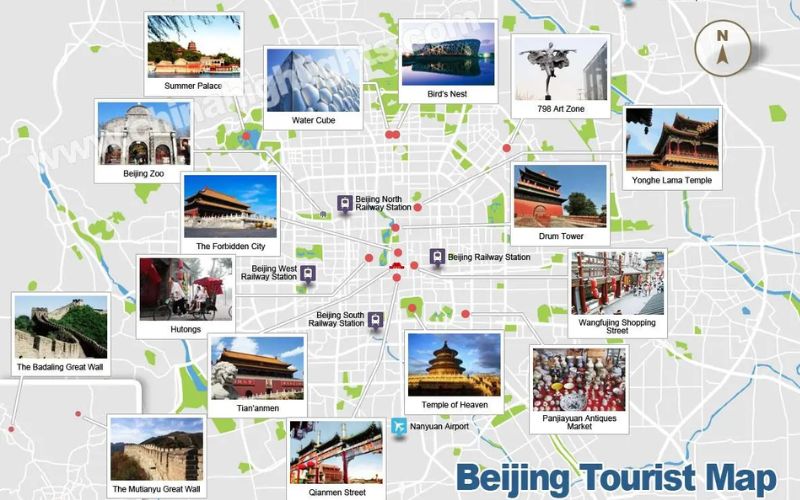
Beijing tourist map
People know about China not only as the country has the most population in the world, but also has many attractions that can be seen a lot in Beijing. This city has a special location which is the same as the apex of the triangular North China Plain and lies at an elevation of nearly 120 feet from sea level. Beijing is not only the national capital but also the center of China’s economy, politics, culture, and science. Although most of the older and more beautiful features have been destroyed during modernization and industrialization since 1949, efforts have been made to renovate and develop many of the city’s ancient sites, so it is clear to see the combination of historical and modern aspects there.
Beijing is a must-see tourist destination in China. Foreign visitors must know about The Great Wall of China – one of the New Seven Wonders of The World, and you can see it when you come to Beijing. If you love visiting an ancient and elegant space, Forbidden City is your best choice. Beijing food can not be missed also, with the famous Peking Duck and Jiaozi (Chinese Dumplings). Particularly, there are many entertainment places such as bar clubs and cafes that will delight your mood. You do not need to worry about not having places to go every day, because that big city has so many amazing things for you to discover during your travel.
Are you ready for a new journey to Beijing? This following travel guide will surely help you.
Weather & Best Time to Visit Beijing
Weather is an important factor to keep in mind when you visit a new city, so we will provide you the very useful information about Beijing’s weather and climate here.
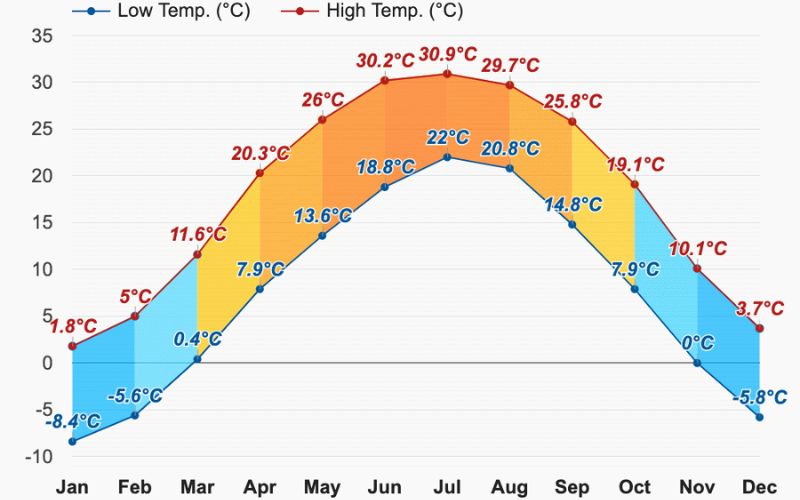
Weather in Beijing
Because of lying in a lowland area and being protected by mountains, Beijing is a little warmer in winter than other areas of China. The annual mean temperature is 53 °F (12°C), with the coldest month being January and the hottest month being July. In an average year, the city has about 130 freezing and dry days between October and March. The rainiest part of the year lasts from June to August with the wettest month being July.
So, the best season to visit Beijing are spring (April and May) and autumn (September and October) when the climate is most pleasant, neither too cold nor too hot, and the scenery is most spectacular. However, there have still exciting activities in all seasons, such as skiing and appreciating snow scenery in the winter. Moreover, hotels and resorts are usually overcrowded and the prices may be higher during the best weather, so in fact, you can travel to Beijing all year round. Each season has its own beauty and special experiences that are worth trying.
Getting to Beijing
By plane
You can take direct flights to Beijing from major cities in the United States, Europe, Australia, and some Asian countries such as Japan, Singapore, Vietnam, Laos, Cambodia, etc.
Beijing International Capital Airport is 32 km northeast of the city center which is not too far, so you can move to Bejing City by airport express train, shuttle bus, or taxi.
By train
Depending on which city you come from, traveling by train may be a better option. Despite being slower than planes, trains in China may bring you new exciting experiences. There are two types: regular trains and high-speed trains, you can easily take one from any cities in China like Hongkong, Shanghai, and Xi’an.
Best Places to Visit in Beijing
1. The Great Wall of China
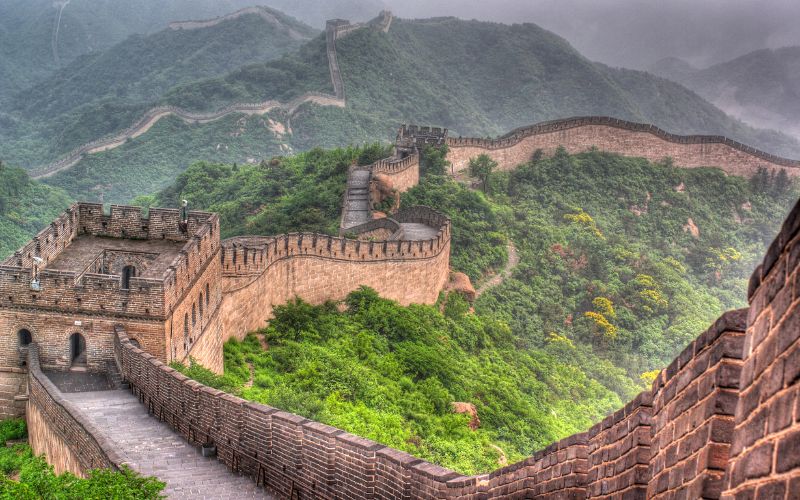
The Great Wall in China
The Great Wall is always a must-see place for Beijing first-time visitors. From the continuous line of the Wall, there are some sections to go near Beijing city, including Badaling Great Wall, Mutianyu section, and Simatai section, the beautiful Jinshanling, steep Jiankou, war-stricken Gubeikou, strategic Juyongguan, unique Huanghuacheng, etc.
The views from the Great Wall are spectacular that surely delight your sense and make you remember forever.
2. The Forbidden City
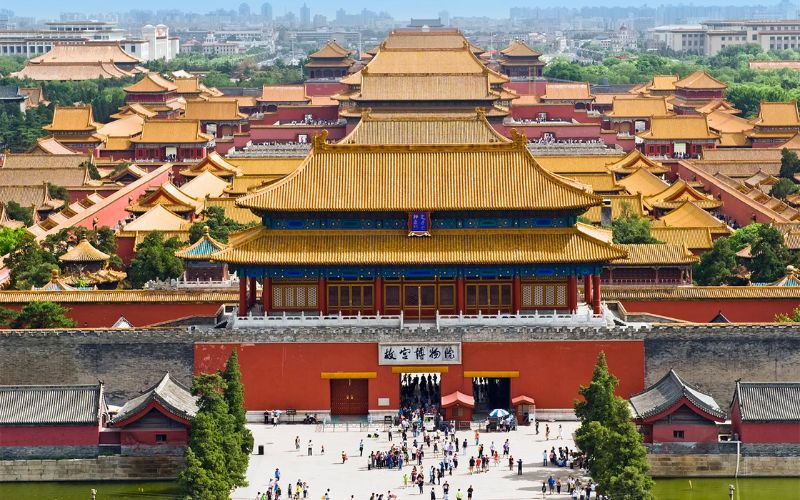
The Forbidden City
Located in the center of Beijing, the Forbidden City (also known as the Imperial Palace Museum) is the home of the kings during Ming and Qing dynasties. Being built in the early 15th century, this architecture is now recognized as a World Heritage site and one of the most well-preserved wooden constructions of the world. Elegantly designed in red and yellow, the Forbidden City represents the social position of ancient emperors during feudalism.
3. Tiananmen Square
It is the city square located in the center of Beijing and only 5 minute’s drive from the Forbidden City. This place was originally built during the Ming dynasty in 1415 and there were many political events happening at Tiananmen Square since then. The most notable one was the declaration of the People’s Republic of China by Mao Zedong in 1949.
Tiananmen Square consists of the Monument of the National Heroes, the Great Hall of the People, the National Museum of China, and the Mausoleum of Mao Zedong.
4. Summer Palace
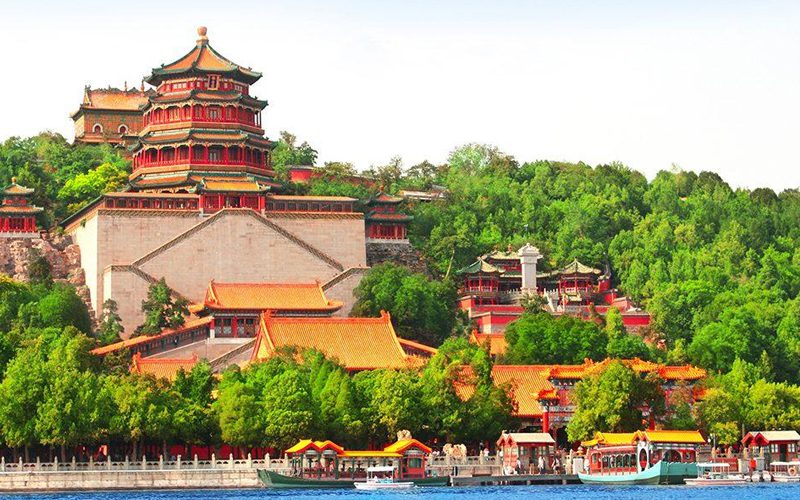
Summer Palace- Beijing
Summer Palace is located 15 kilometers northwest of Beijing. This splendid architecture was once a getaway place owned by Chinese imperial families from sultry Beijing in summer. It is a vast complex of lakes, gardens, and palaces with two highlights: a three-story Great Opera Hall and a Hall of Joy and Longevity (Le Shou Tang Hall) with rustic gardens and courtyards. The best time to visit this place is during summer when cruises are accessible.
5. Beijing Hutongs
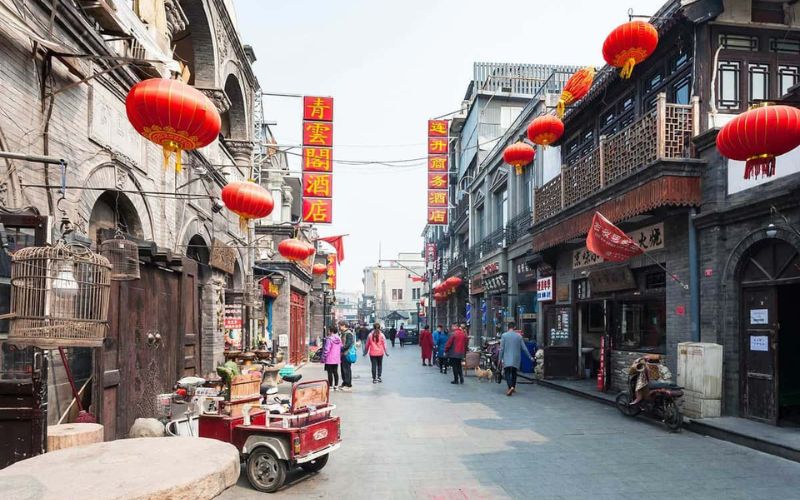
Beijing Hutongs
In English, Hutong is another name for a lane or an alley. This place is a quaint small alley with narrow roads and one-story buildings. Hutongs are perfect for your photo shoots with tranquil scenery and rustic architecture. You can spend your time in souvenir stores, craft-making classes, and cooking classes on your Hutongs tour. Immersing yourself in an ancient alley and attending a culinary class is the best way to understand Chinese culture authentically.
6. The Temple of Heaven
The Temple of Heaven is considered the most important imperial temple in China. Being built in 1420 by a Ming emperor, this place was used to pray for a good harvest. Visiting this temple, you will understand ancient Chinese people’s perspectives on the relationship between sky and earth and how traditional solar terms were applied in architecture.
7. Lama Temple
Lama Temple, also known as Yonghe Temple (Palace of Peace and Harmony), is the biggest Tibetan Buddhist Temple in China. There are five courtyards in this temple and The Hall of Boundless Happiness is the highlight of Lama Temple with a magnificent 26-meter-high Buddha statue.
8. Bell and Drum Towers
These two towers were originally constructed in 1272 during the Yuan dynasty. These two towers functioned as time-announcing places during ancient dynasties. You will see a King Bell and drums in Bell and Drum Towers respectively which were beaten to announce the hour. Climbing the steep stairs of these two buildings, you will get the whole view of poetic Beijing.
9. Ming Tombs
50 kilometers from the northwest of Beijing, Ming Tombs are the system of 13 imperial tombs constructed by the emperors of the Ming dynasty. This attraction is located in a strategic position according to feng-shui rules: it is on the slope of a mountain and there is a river flowing near it. Please note that there are only three Ming tombs that are open for tourists: Dingling, Changling, and Zhaoling tombs.
10. Beijing Temple of Confucius
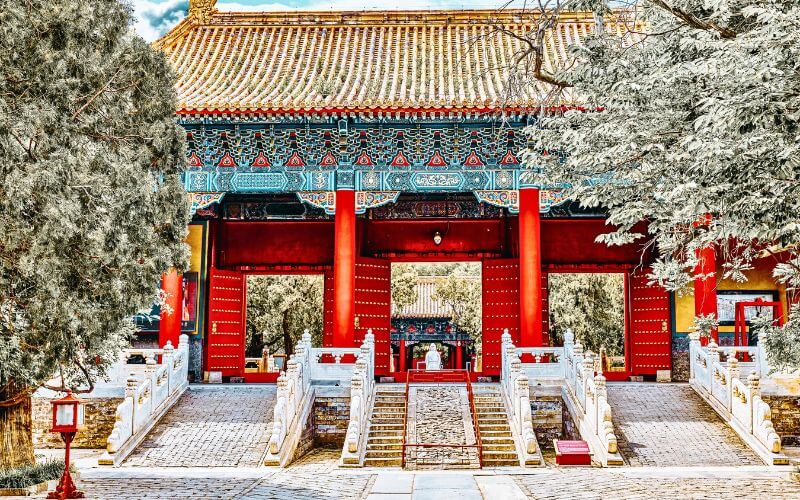
Beijing Temple of Confucius
With an area of more than 20,000 square meters, the Beijing Temple of Confucius is considered the second-largest temple functioning for Confucianism worshipping in China. Confucius is an influential teacher and philosopher in China. He founded Confucianism, ethical and philosophical codes that were strictly followed by imperial dynasties during feudalism.
Things to Do in Beijing
1. Explore the Great Wall of China
A must-do thing when you come to Beijing is to see the Great Wall of China covered extensively in previous parts as a wonderful highlight spot. You should spend a long time enough to visit both the Mutianyu and Jiankou sections.
2. Visit Tiananmen Square
Tiananmen Square is known as the world’s largest square and has been the site of several demonstrations in recent history. Nowadays, this place is a huge area of paved roads and sidewalks, heavily guarded by police and security guards. When you come to Beijing during a convention, you have to wait for long security checks just to enter and exit the square. You can walk on wide sidewalks, alongside concrete, and communist-style buildings. Although there have not many things to see, thinking about history is really amazing.
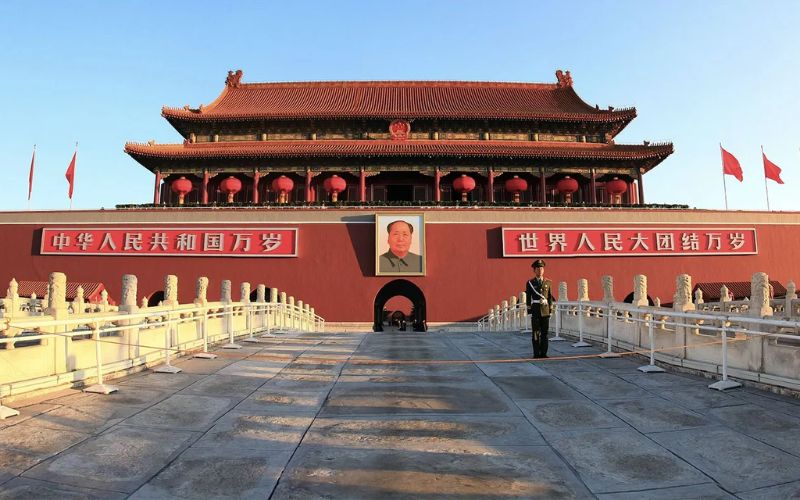
Tiananmen Square
3. Go to Forbidden City
Some people say that not going to the Forbidden City would be like going to Paris without setting foot in the Louvre or Eiffel Tower. For 500 years, this collection of buildings is the house of two dynasties with imperial rule and also is the largest palace complex in the world. When you remember the Beijing trip, surely you will see images of the Forbidden City at first.
You can spend several hours touring this enormous complex of palaces, temples, and smaller exhibits. To have an impressive view of the Forbidden City, it is advisable to see from the large courtyard, from the Gate of Supreme Harmony. A visit to the Forbidden City usually takes all day, please note that the closing time is at 3:30.
4. Admire Beijing’s Famous Temples
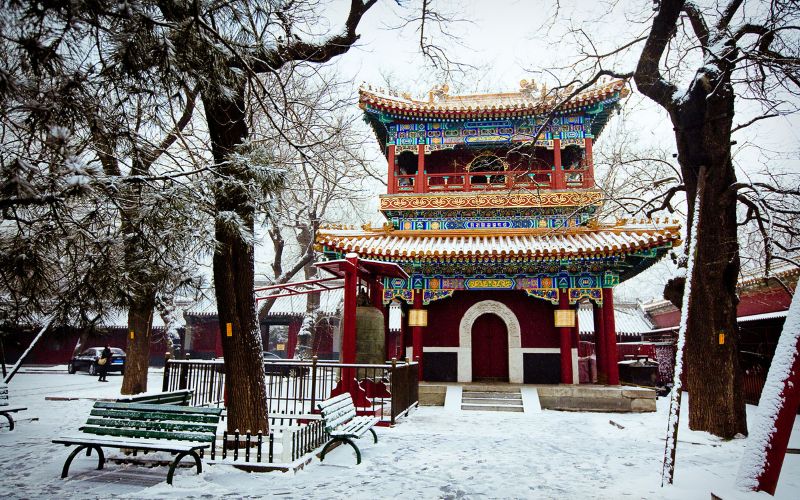
Lama Temple in winter
Beijing has a lot of temples, like many other cities in Asia. The Lama Temple and the Confucius Temple are most appreciated in Beijing. The Lama One is a large complex of Buddhist temples. You can not only go there to visit but also pray and worship. Clouds of incense-scented smoke filled the air as people worshipped and paid their respects which creates a spectacular scene. Groups of people walked from temple to temple, burning incense and praying, all very spiritual and very beautiful and memorable.
5. Watch a local art performance
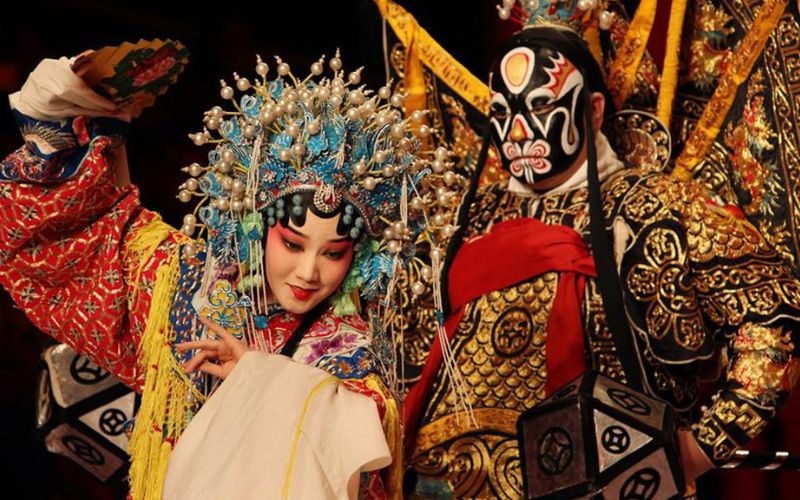
Peking Opera
Peking Opera is a classic art form that is unique with its colorful costumes and combination of singing and other performing arts such as dialogue, acrobatics, dancing, or martial arts. You can still watch and enjoy this plot to feel it’s comprehensible without understanding Chinese. Children are usually interested in watching Kung Fu shows and Acrobatics shows. All the skillful performers, elegant costumes, and exciting skills of actors will bring you an unforgettable night in Beijing.
6. Go shopping
Beijing has a lot of shopping malls and shopping districts. You can pay a quick visit to Wangfujing Street, which is called the Champs-Elysees of Beijing. Just off Wangfujing Street is a pedestrian street filled with typical Chinese souvenirs and delicacies such as cockroaches and scorpions.
What to eat in Beijing
1. Peking Duck
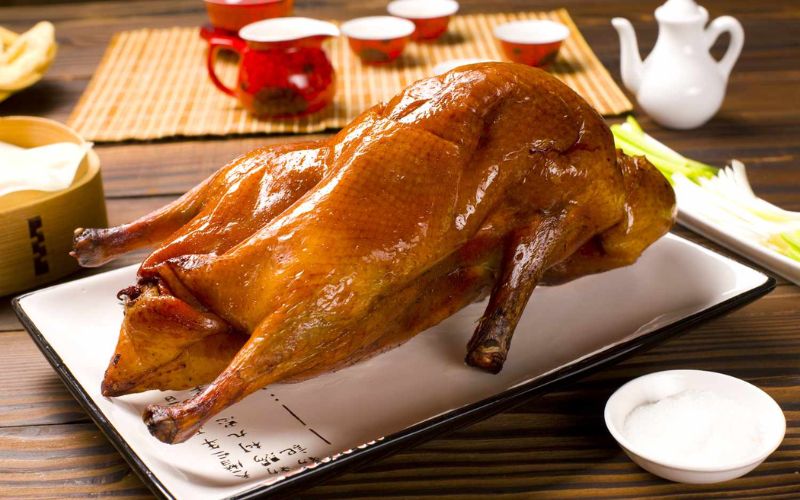
Peking Duck
It is said that someone visits Beijing without eating Peking Duck. Ducks are seasoned before being hung and roasted in an oven to create a vibrant red color and crispy skin. The chefs usually slice the duck in front of you; they will ensure that each thin flake has its own piece of brownish-red skin.
You can taste this special dish directly with sauce; however, it is also good if you taste it with pancakes and some vegetables. People usually put the pancake on their palms, spread the plum sauce, and finally put some cucumbers and carrots with a piece of duck, then wrap and eat it with sauce. Beijing Roast Duck will be ideal to enjoy in spring and autumn when the weather is pleasantly cool.
2. Beijing Mutton Hotpot
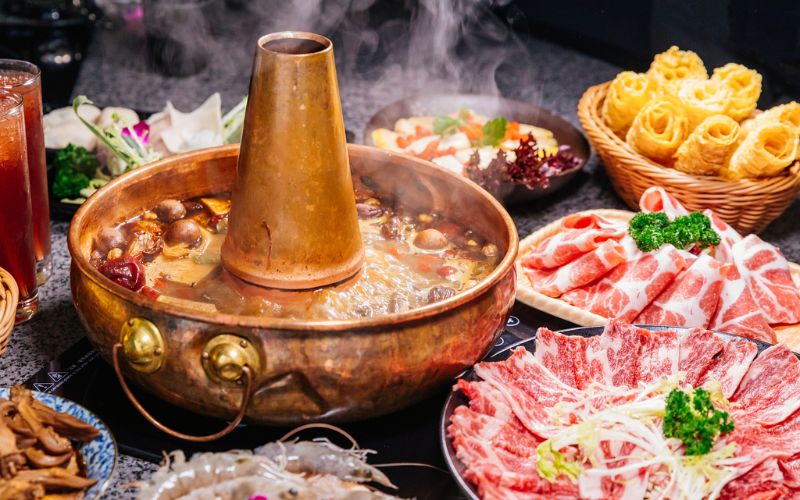
Beijing Mutton Hotpot
Beijing Mutton Hotpot is the most famous style of hotpot in China, in which the soup is heated in a copper pot with a coal-burning stove on its base. The soup in which the mutton is boiled is considered very good for your general health because of the herbs used in it.
The sauce that you dip the meat into while eating the Mutton hotpot plays an important role in the flavor of the dish. It is usually a mix of chili oil, sesame seed oil, minced scallion, and flowers from the Chinese chive.
3. Beijing Jing Jiang Rou Si
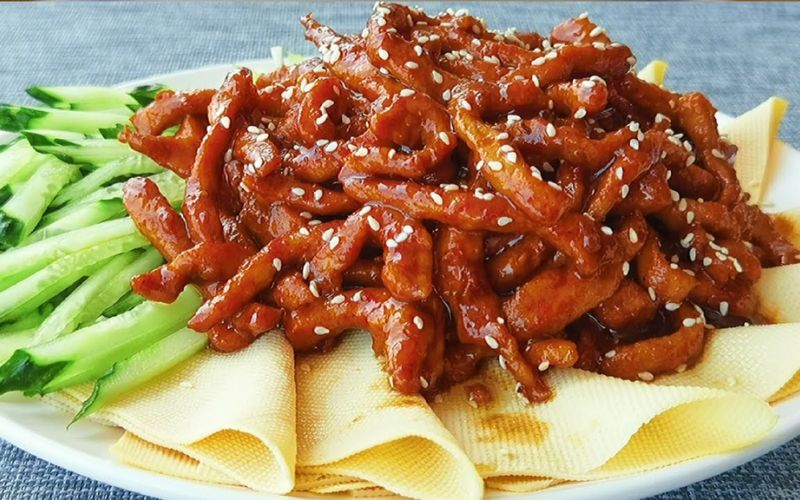
Beijing Jing Jiang Rou Si
This is a traditional cuisine that originated in Beijing. It consists of sliced pork meat cooked in a sauce based on sweet beans, then traditionally rolled in soya bean wraps, although it can be wrapped in any type of pancake. The dish is reddish in color due to the distinctive Beijing sauce in which it’s cooked and is usually garnished with chopped green onions or shredded leeks. There are some regional varieties of it with either sha cha sauce or hoisin sauce replacing the sweet bean sauce in the process.
4. Zhajiangmian (Beijing Fried Sauce Noodles)
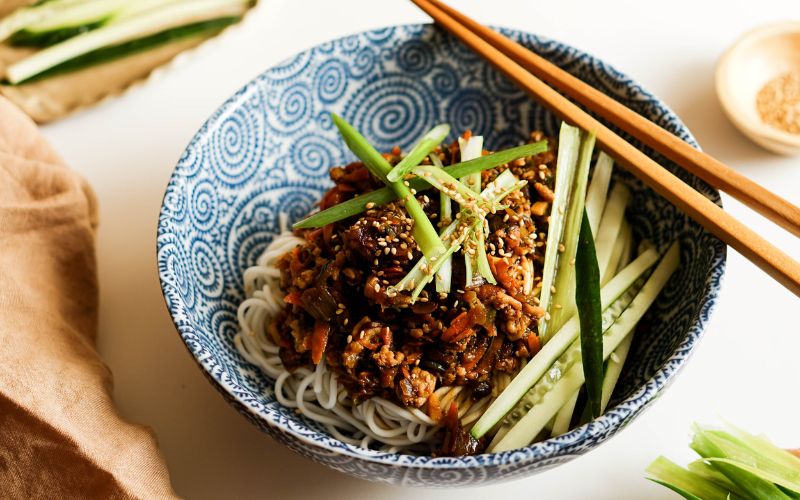
Zhajiangmian
Carbohydrate dish plays an important role in your Beijing cuisine adventure. Zhajiangmian (or Beijing Fried Sauce Noodles) is made from thick wheat noodles mixed with eggs and some vegetables such as bean sprouts, radishes, carrots, and cucumbers. Ground pork or beef and soybean paste are used to make this food’s sauce. It probably looks like spaghetti bolognese, but instead of a tomato-based meat sauce, you have a fermented soybean meat sauce instead. Fermented soybean paste or commonly labeled as bean sauce, is packed with a ton of rich and savory umami flavor.
5. Jiaozi (Chinese Dumplings)
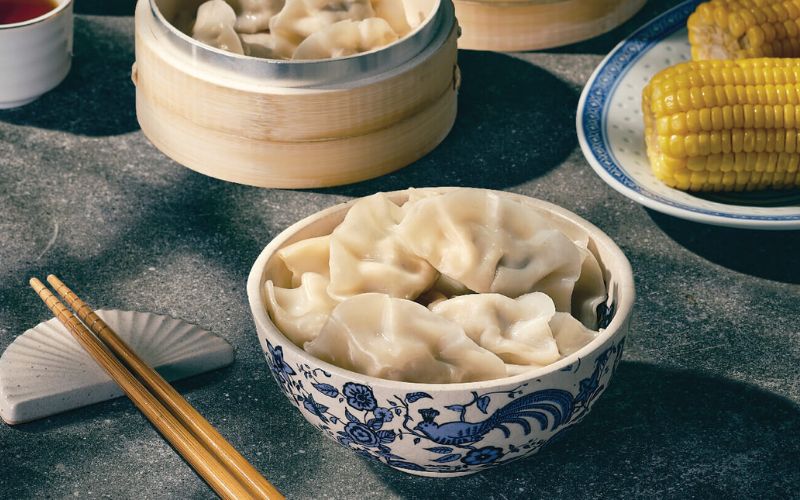
Jiaozi
There are many types of Chinese dumplings but the most classic one is jiaozi. Jiaozi is typically made with a meat or vegetable filling, wrapped inside a thin piece of dough, with the edges sealed. They are then steamed, boiled, or pan-fried.
Jiaozi is a well-known kind of dumplings in Beijing. Some countries are interested in this food and make it on their own, such as Vietnam.
6. Donkey Burger
This dish’s origin is in Hebei province and it is well-known in Beijing now. Lean donkey meat will be shredded and wrapped in round or rectangular buns. This food is rich in protein and suitable to try after your long walking tour in Beijing.
7. Street Food
Located in the North-Central of China, Beijing street foods have a strong flavor with seasonings such as garlic, ginger, onion, and pepper. However, they are adapted so that international tourists can sample the quintessence of Chinese cuisines. Imperial cuisine is prevalent in this ancient capital and tourists can easily find some local restaurants which serve the classic Chinese cuisine.
Some food you must try is a type of Chinese snack—a salty crepe called Jianbing, Baozi, Jiaozi, Youtiao (or Fried Dough Sticks), Jidan Guan Bing (or Egg Filled Pancake). You can easily find a place in a Beijing street food market like Naluoguxiang night market, or on a famous Beijing food street like Wangfujing, Qianmen, and Jiumen Snack Street.
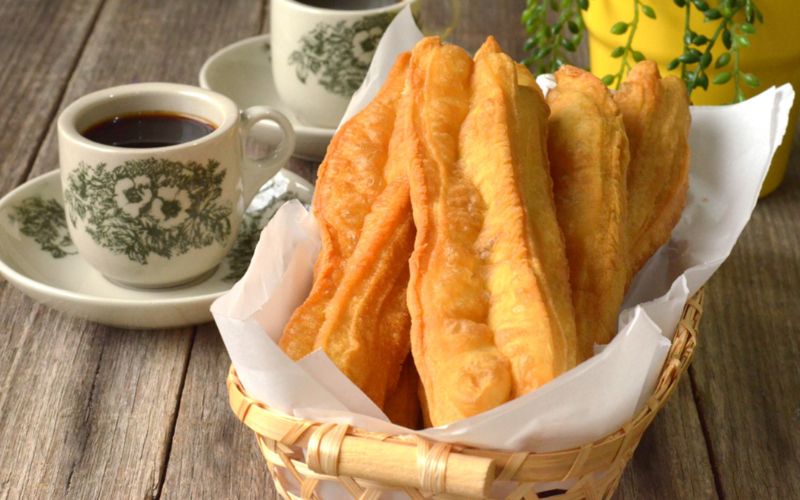
Youtiao
Souvenir of Beijing
1. Jasmine Tea
Jasmine tea is firmly a special gift from China, which has been used very popularly in this country since the Qing Dynasty. The high-quality jasmine tea is made from green tea and is scented with fresh jasmine flowers. It is one of the best flower tea varieties so you should not miss buying it as a gift for your family and friends.
2. Beijing Dough Toys
The Beijing Dough Toy is a traditional Chinese folk handicraft, which became popular at the beginning of the 21st century. The dough toy is made of wheat and sweet rice flour, then the artist shapes the dough skillfully into people and animals with a bamboo knife in a short time. Among the figures are beautiful princesses, adorable children, and various historical people.
The dough toys are small, making them one of the best souvenirs. As it is an ancient handicraft, tourists can find them at temple fairs during the Spring Festival.
3. Peking Glass Snuff Bottle
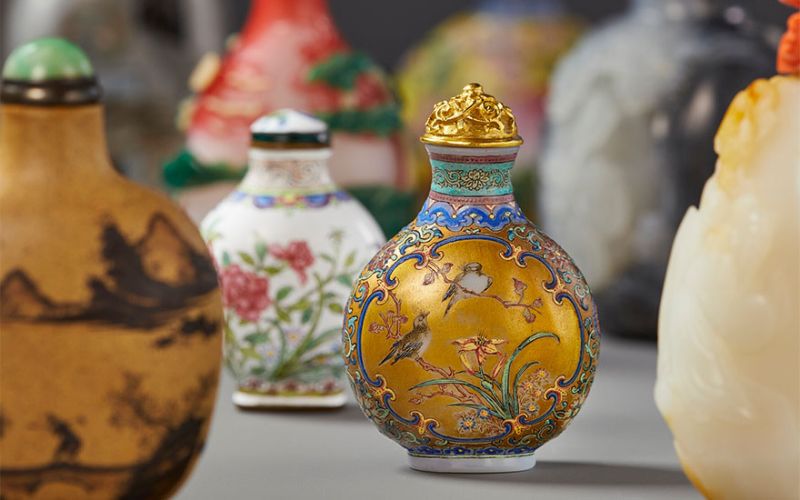
Peking Glass Snuff Bottle
The Peking glass snuff bottles are a traditional Chinese handicraft that is very popular in China and abroad. The snuff bottles are made of special materials like jade with a unique shape. Ones painted on the inside are particularly famous and admired by collectors, while most of the paintings inside the bottles are Chinese style, with vivid pictures, simple colors, and elegant layouts, giving them a great collection value. They are also called reverse painted due to this technique.